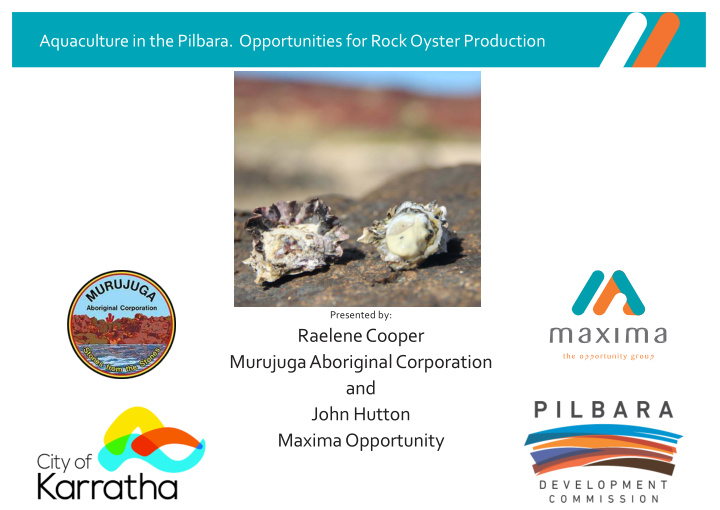



Aquaculture in the Pilbara. Opportunities for Rock Oyster Production Presented by: Raelene Cooper Murujuga Aboriginal Corporation and John Hutton Maxima Opportunity
Aquaculture in the Pilbara. Opportunities for Rock Oyster Production AustralianAquaculture – Snapshot (excl Pearls) • Total seafood production is $2.5 b / year. • Aquaculture production is $1 billion. • Employs 14,000 people. ( ABARES 2015) • Aquaculture focus on high value, quality product. Rock Oyster Snapshot • NSW ,SA and Tasmania • $1oo million industry • Produced 16.5 Million dozen 2007 • Species: Pacific Oyster and Sydney Rock Oyster
Aquaculture in the Pilbara. Opportunities for Rock Oyster Production WesternAustralianAquaculture Underperforming Relative toOtherStates Source: ABARE Fisheries Statistics 2012
Aquaculture in the Pilbara. Opportunities for Rock Oyster Production WA’s Growth Opportunity Changing Regulatory Environment • New Aquatic Resource Management Act 2016 • Combine Pearling Act and Fisheries Resource Management Act • All Pearling Leases will become Aquaculture Leases. • Currently 63,000 hectares of WA Marine Estate are Pearling or Aquaculture leases • Approx. 60,000 are Pearling Leases • Vast areas of water will become available for Aquaculture. Investment in Multi-species Mollusc Hatchery • WA Government - 5 year funding for the hatchery $2.3 Million investment • Produce commercial quantities of oyster spat •
Aquaculture in the Pilbara. Opportunities for Rock Oyster Production Why Aquaculture in the Pilbara? PhysicalAttributes • Large areas of relatively protected water. • Good water quality with large tidal flows • Limited urban development and human impact • Good transport links • Close toAsian Markets Government support • 9 of 11 Regional DevelopmentCommissions id entifie dAquaculture • Compliments tourism industry
Aquaculture in the Pilbara. Opportunities for Rock Oyster Production What Species in the Pilbara ? PDC contracted Fisheries WA to identify potential Aquaculture species. • Identified the most likely species is Rock Oyster . • Some challenges identified • Need R&D trial to address the risks and challenges
Aquaculture in the Pilbara. Opportunities for Rock Oyster Production The Partners in Rock Oyster Project Murujuga Aboriginal Corporation • Economic development opportunity Real jobs on country and career paths • • Complement tourism venture Pilbara Development Commission Attract sustainable industries to the region • • De-risk investment City of Karratha • Support economic diversification opportunities Maxima Pearling Company Pearling Leases • • Pearling vessels Expertise in oyster culture • • Experienced in “start up” aquaculture projects Fisheries Research and Development Corporation on behalf of the Australian Government. • Funding Project management •
Aquaculture in the Pilbara. Opportunities for Rock Oyster Production Pilbara Rock Oyster Research and Development Project. Benefits Risks • No Shellfish Quality Assurance Program • Natural rock oyster populations • Biosecurity and disease risks • Existing Pearl Oyster leases • Growth and survival rates unknown • Successfully produced Pearl Oysters • Risk of cyclone • Knowledge from Pearling industry • Pearling vessels available • WA Government oyster hatchery. • Good transport links • Complement tourism industry Burrup Peninsula Oyster Racks (Western Rock Oysters)
Aquaculture in the Pilbara. Opportunities for Rock Oyster Production Pilbara Rock Oyster R&D Project Target 1,000 dozen oysters Research to establish • Growth rates • Survival rates • Seasonal Condition for market • Shellfish Quality Assurance Program • Test for all risks to human health • Ongoing water and oyster sampling regime
Aquaculture in the Pilbara. Opportunities for Rock Oyster Production Map of Pilot Project Sites Intertidal trial sites Existing Pearl Lease
Aquaculture in the Pilbara. Opportunities for Rock Oyster Production Species and Equipment Species • Western Rock Oyster. Saccostrea cucullata • Tropical Black Lip Oyster. Saccostrea echinata Production system • Adjustable height, multi-line and basket systems used in Australian Oyster industry.
Aquaculture in the Pilbara. Opportunities for Rock Oyster Production Flying Foam Passage (Pilbara) Vs Coffin Bay, South Australia • The production area is roughly the same. • Coffin Bay Oyster - recognizable brand in Australia • Coffin Bay 40 independent growers (working together) • Employing over 100 people. • Geographically Remote -approximately 700km from Adelaide. • First Pacific Oysters introduced in the 1970’s • Commercial Production began in the 1990’s. Flying Foam Passage, Pilbara Coffin Bay, South Australia
Aquaculture in the Pilbara. Opportunities for Rock Oyster Production Other Water Users Flying Foam Passage has high recreational boat traffic. • Trial in the intertidal zone • Not in navigable channel The site buoy marking complies with Department of Transport • Aquaculture sites are not exclusive. It is an offence under the Fisheries Act to interfere with Aquaculture Equipment.
Aquaculture in the Pilbara. Opportunities for Rock Oyster Production For further information contactSteven Gill Mobile: 0488 698 875 Email: steven.gill@maximaopportunity.com.au Web: maximaopportunity.com.au lateralaspect.AM1188
Recommend
More recommend